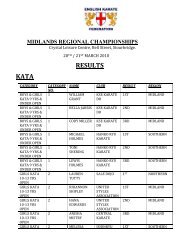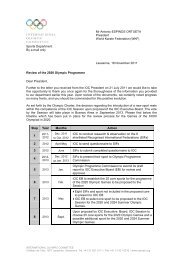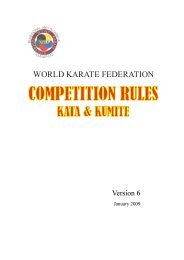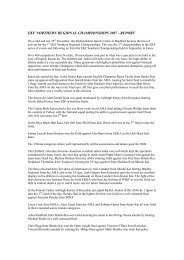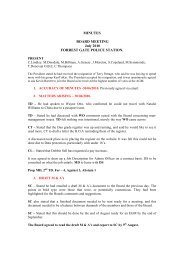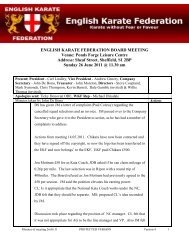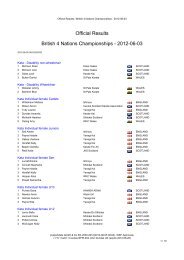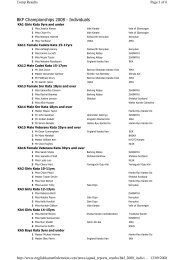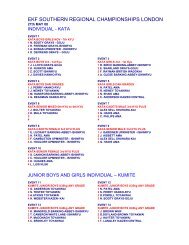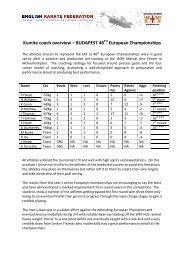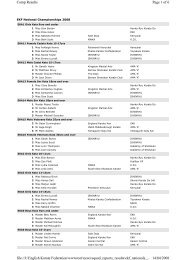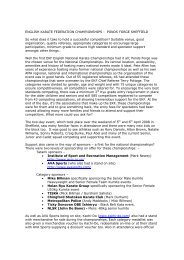WKF Rules Version 7.1.pdf - Karate New Brunswick
WKF Rules Version 7.1.pdf - Karate New Brunswick
WKF Rules Version 7.1.pdf - Karate New Brunswick
You also want an ePaper? Increase the reach of your titles
YUMPU automatically turns print PDFs into web optimized ePapers that Google loves.
15XII.XIII.XIV.XV.XVI.Open hand techniques to the face are forbidden due to the danger to the contestant’s sight.JOGAI relates to a situation where a contestant's foot, or any other part of the body, touchesthe floor outside of the match area. An exception is when the contestant is physically pushedor thrown from the area by the opponent. Note that a warning must be extended for the firstinstance of JOGAI. The definition for JOGAI is no longer ―repeated exits‖, but merely ―exit notcaused by the opponent‖.A contestant who delivers a scoring technique and then exits the area before the Referee calls―YAME‖ will be given the value of the score and Jogai will not be imposed. If thecontestant’s attempt to score is unsuccessful the exit will be recorded as a Jogai.If AO exits just after AKA scores with a successful attack, then ―YAME‖ will occurimmediately on the score and AO's exit will not be recorded. If AO exits, or has exited asAKA's score is made (with AKA remaining within the area), then both AKA's score will beawarded and AO's Jogai penalty will be imposed.It is important to understand that ―Avoiding Combat‖ refers to a situation where acompetitor attempts to prevent the opponent having the opportunity to score by using timewastingbehaviour. The contestant who constantly retreats without effective counter, whoholds, clinches, or exits the area rather than allow the opponent an opportunity to score mustbe warned or penalised. This often occurs during the closing seconds of a bout. If the offenceoccurs with ten seconds or more of the bout time remaining, and the contestant has noprevious C2 warning, the Referee will warn the offender by imposing CHUKOKU. If therehas been a previous Category 2 offence or offences, this will result in KEIKOKU beingimposed. If however, there is less than ten seconds to go, the Referee will directly imposeHANSOKU CHUI on the offender (whether there has been a previous Category 2 KEIKOKUor not). If there has been a previous Category 2 HANSOKU CHUI the Referee will penalisethe offender with HANSOKU and award the bout to the opponent. However, the Referee mustensure that the contestant’s behaviour is not a defensive measure due to the opponent actingin a reckless or dangerous manner, in which case the attacker should be warned or penalised.XVII. Passivity refers to situations where the one or both of the contestants do not attemptto exchange techniques over an extended period of time.XVIII. An example of MUBOBI is the instance in which the contestant launches a committed attackwithout regard for personal safety. Some contestants throw themselves into a long reversepunch,and are unable to block a counter. Such open attacks constitute an act of Mubobi andcannot score. As a tactical theatrical move, some fighters turn away immediately in a mockdisplay of dominance to demonstrate a scored point. They drop their guard and lapseawareness of the opponent. The purpose of the turn-away is to draw the Referee's attention totheir technique. This is also a clear act of Mubobi. Should the offender receive an excessivecontact and/or sustain an injury the Referee will issue a Category 2 warning or penalty anddecline to give a penalty to the opponent.XIX.Any discourteous behaviour from a member of an official delegation can earn thedisqualification of a competitor, the entire team, or delegation from the tournament.* VERSION 7.1 – Effective from 01.01.2012



